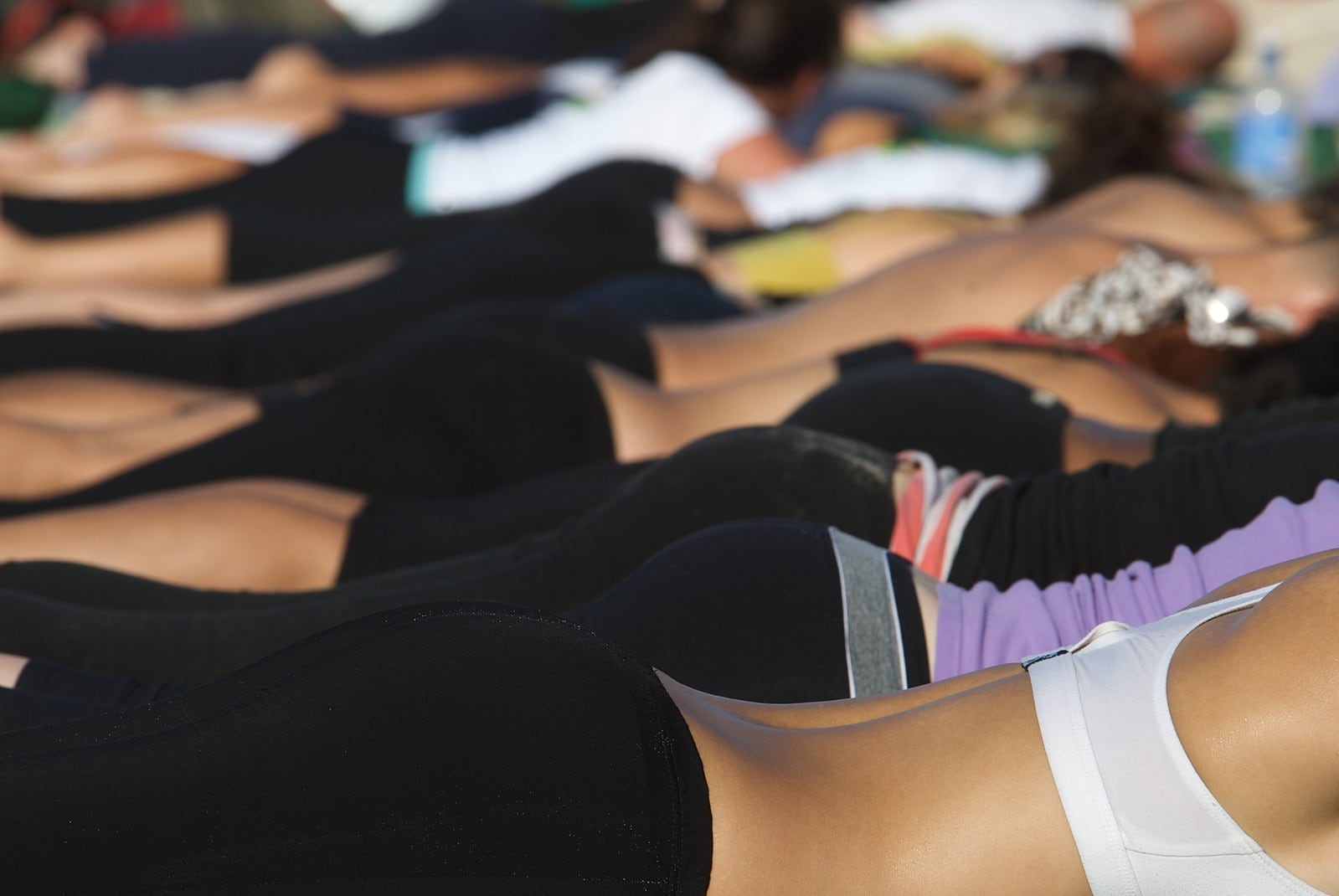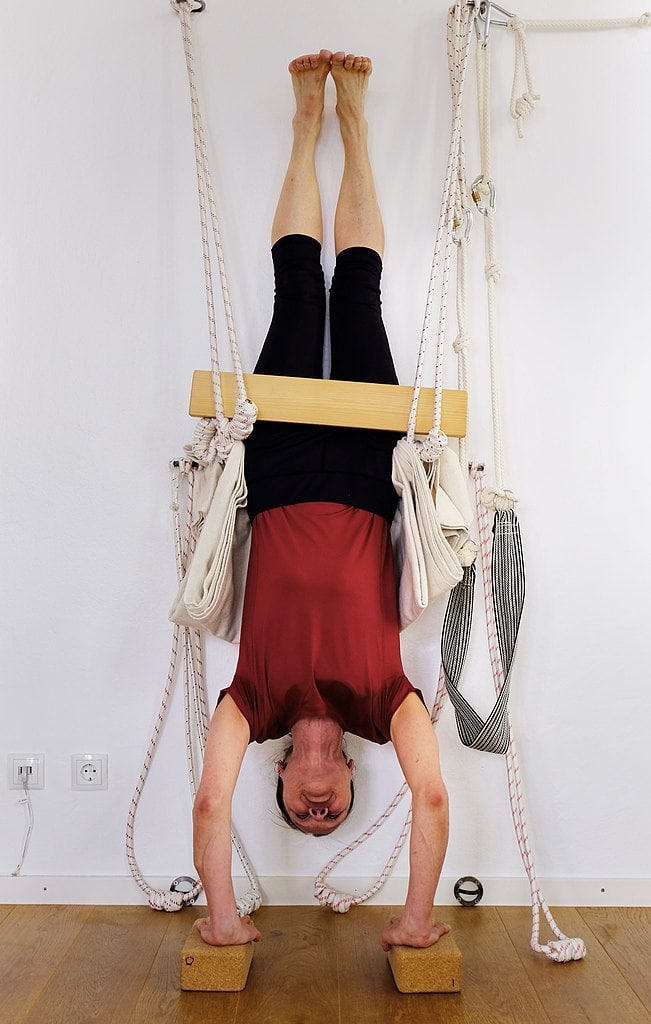Two slanted almond-shaped eyes, rimmed with kohl were like a perfect promise of the exotic Orient, the imagined seduction of an dark-skinned, long-haired, curvy belly dancer who lasciviously dropped her veil. Strangely, there was a third eye between the eyebrows, vertically upward and open. Stranger still, a cobra wriggled between them, lifting the front of its body and displaying its flattened neck. It was an advertisement for a yoga school, displayed on a billboard under a public clock.
Considering that yoga – in its gentle flow and tone – is usually associated with stress reduction and physical relaxation, perhaps physical flexibility, improved concentration and higher energy, perhaps restoring balance of the body and mind and, if one is lucky, uniting them, indeed, if one is lucky, the big E word – enlightenment – this was a loud and flashy advertisement.
While running errands and riding my bike around town, I noticed the ads in two different places. The school had consistently bought advertising space underneath public clocks.
That is clever, I thought.
“Hot, Hip and Holy” was the catchy headline in striking purple, and there was a sub-headline in Sanskrit letters.
That is really clever, I thought.
In recent decades, yoga has experienced an unprecedented surge in popularity. Millions of people in the West have taken to the mat, some of them inspired by celebrities who have been photographed on their way to yoga classes with the obligatory yoga mat under their arm. In the United States alone, some 15 million people practice yoga, three times as many as a decade ago.
Today there is an influx of yoga instructors who most often have radically changed their life style, taken up classes to become teachers at the forefront of the yogic body and who were once like those they now teach – in need, seeking refuge from the high pressures of their jobs and the increasing demands of modern, fast-paced and hectic lives, and immersing themselves in the teachings in search of salvation, healing, peace, happiness, rejuvenation and authenticity.
Yoga schools and yoga studios mushroomed in the urban mycelium of the West. The yoga school with the attention-getting slogan had already enjoyed great success in New York. When the second wave of the yoga boom reached the West in the mid-1980s, it must have been clear to the school’s founders that there was a thriving business to be had here.
According to a 2008 market study in the United States commissioned by the Yoga Journal, Americans spent about six billion dollars a year on yoga classes and products, including equipment, clothing, retreats/vacation stays and media such as DVDs, videos, books and magazines, an increase of nearly 90% in four years.
Now the self-proclaimed yoga tribe with the 3-H slogan wanted to expand in the European market, which supposedly had growth potential and was not yet saturated compared to the American market. Ironically, the Western adherents of yoga betrayed its principles to the very world they once sought to escape and promised to overcome: the ordinary world of profit-driven capitalism with its glossed-over glorification of material ideals.
Today, thanks to a very aggressive propagation, yoga has experienced a worldwide boom in a relatively short time.
“It would seem that in their hurry to popularize something called ‘yoga’, high-flying gurus with an aim to build powerful organizations, have not bothered to find out what yoga really is, looking upon it as another form of sport, entertainment… or at the lowest, a popular product to sell.”
Based on the reduction to a few basic asanas(postures and stretches) and pranayama(breathing techniques), yoga has become a mainstream movement, a modern life style with mass appeal and a certain hipness factor. Swami (Master) Gitananda Giri, a world-renowned authority on yoga who was formerly a heart surgeon and taught yoga in a scientific-medical approach openly criticized, “It would seem that in their hurry to popularize something called ‘yoga’, high-flying gurus with an aim to build powerful organizations, have not bothered to find out what yoga really is, looking upon it as another form of sport, entertainment… or at the lowest, a popular product to sell.”

Image: Parliament of Religions September 1893. On the platform (left to right) Virchand Gandhi, Anagarika Dharmapala, Swami Vivekananda and G. Bonet Maury.
Modern yoga and the philosophy of Hinduism gained prominence in the West after a young mystic spoke at the Parliament of Religions in Chicago in 1893. Swami Vivekananda, a monk from an aristocratic family who was sent to the U.S. by his teacher Ramakrishna without knowing a soul, captivated the American audience. He simplified the aspects of spiritual yoga and actively spread them. His simple recipe for life, with the slogan “Work and Worship,” was well received by the Western lifestyle. He toured the United States and Europe, opening the doors for other Hindu gurus to follow. Swami Vishnudevananda, who was sent to the West by his guru Sivananda, was nicknamed “The Flying Swami” because of his yogic abilities. His book, Complete Illustrated Book of Yoga, published in 1959, was read by many. Ten years later, spiritual master and yoga adept Swami Satchinanda was the opening speaker at the Woodstock Festival.
Just a year earlier, the Beatles and Mia Farrow had traveled to India to receive the teachings of Maharishi Mahesh Yogi, the founder of Transcendental Meditation (TM). Western interest in yoga and Hindu spirituality reached its first peak, and a hippie-mysticism-movement was underway. Schools emerged that catered specifically to a Western clientele. Emphasizing a physical culture, Hatha yoga was the most popular form of yoga when special forms such as Iyengar and Kundalini yoga were introduced. While B.K.S. Iyengar had developed a form of hatha yoga that used props such as blankets, straps, and blocks to support the postures and could be used as a complement to physical therapy in the treatment of ailments, diseases, and disorders, Yogi Bhajan challenged the tradition of secrecy that had surrounded the practice of Kundalini yoga for many thousands of years. He defied the precepts and taught Kundalini Yoga publicly in the West, causing an uproar in the traditional Sikh community. Furthermore, he encouraged his students to marry, start businesses, and engage in social activities rather than commit to a yoga tradition that valued asceticism and renunciation.
Continue reading in Hip, Hot and Holy – part 2
Image header: Sascha Kohlmann, imported by the Archive Team, CC-BY-SA-3.0






